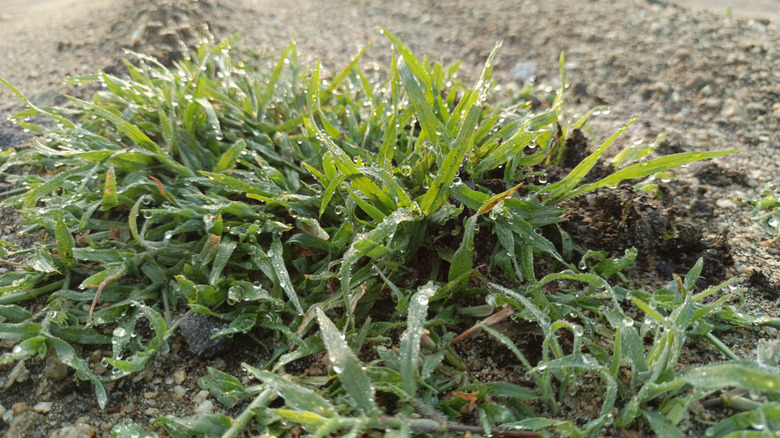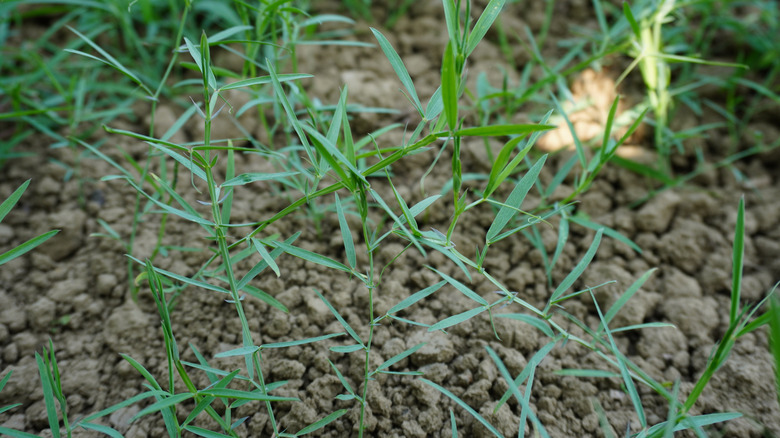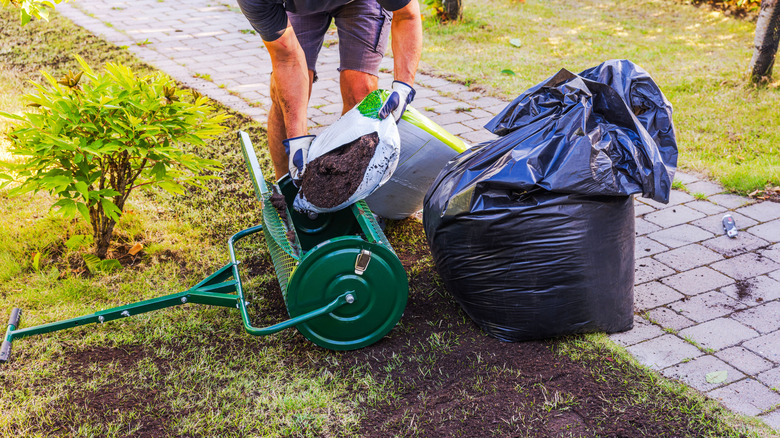To Banish Nimblewill Weeds For Good, Pay Attention To Your Soil's Health
If you're trying to get rid of nimblewill, you've probably already recognized just how hardy and tenacious this grassy plant can be. Hand-pulling it can almost feel pointless because even a tiny fragment left behind can put out new growth. Being a grass, your options for herbicides are limited as most will kill your desirable plants as well as the weed. The few targeted herbicides that can kill nimblewill without harming your lawn often must be applied by a professional.
The good news is you technically don't have to do anything about it. Nimblewill (Muhlenbergia schreberi) is actually a native, warm-season grass throughout much of the United States. Since it typically outcompetes your lawn precisely in the areas where your turfgrass is struggling to grow, you can simply allow this native to fill in those patches. In a cool-season lawn, these patches will be more noticeable at the beginning and end of the season, especially in the colder parts of its range, as nimblewill only greens up for the warmest months of the year. In the warmer parts of its range or in a warm-season lawn, it might blend in a bit better.
However, if you've got nimblewill invading a flower bed or you just don't like the look of it in your lawn, the key to getting rid of it for good is figuring out the soil and light conditions that are allowing it to thrive. Here's why you shouldn't ignore your lawn's soil health when trying to keep weeds out. You'll also find some tips to adapt your yard to keep the grassy plant out for good.
What nimblewill is saying about your soil health
Nimblewill is an impressively adaptable plant. It thrives in nutrient-poor sites, shady conditions, and wet, poorly-draining soil. But it also does just as well in sunnier areas with drier soils. To figure out what's going on in your own yard, check the health of your soil and other characteristics of the sites where nimblewill is thriving most.
If it's the shadier parts of your lawn, nimblewill is telling you that your turfgrass isn't shade-tolerant enough for those areas. If it's in a low-lying area, especially one that tends to stay soggy after rain, the weed is telling you that the soil is too wet or poorly draining for your turfgrass. If it's growing in the hottest, sunniest part of your lawn, you've probably got turfgrass that can't take the heat as well as nimblewill. That's especially likely if you've planted cool-season grass or a less drought-tolerant species in a hotter climate.
If the nimblewill is taking over a garden bed rather than your lawn, there might just be too much bare soil available between your plants. Nimblewill likes disturbed soil, such as the freshly tilled stuff in between the annuals you just planted. But its presence can also indicate the same issues mentioned above. It might be a sign you're watering too much, for example, or that the soil doesn't drain well enough. It might even mean you've planted a sun-loving species in a spot that's simply too shady.
How to use soil health clues to keep nimblewill weeds out
Once you've diagnosed the soil health issues that are allowing nimblewill to thrive while your lawn or flower beds suffer, you have three options. The first is to amend the soil or environmental conditions to better suit the plants you want to grow there. The second option is to replace your struggling plants with species that like the conditions you already have — and, therefore, can better compete with nimblewill.
To amend the soil, layer in compost. Whether your soil is too sandy or too clay-heavy, adding plenty of organic matter is the solution. This will improve both drainage and nutrient levels, so just about any conditions that are allowing nimblewill to outcompete your plants are solved by topdressing with compost. In garden beds, add a layer of organic mulch (like leaves or wood chips) as well. This can help with weed suppression in the short term and improve soil health in the long term as the organic matter breaks down, feeding the soil.
If you'd rather just replace your struggling plants with something better adapted to the area, go back to the soil and light condition clues that nimblewill gave you. For example, if it's taking over a shady, moist area, look for plants that thrive in the same shady, moist conditions. For best results, search for plants native to your region. Then, be sure to plant densely so that your new plants can crowd out weeds. But, you'll need to continue hand-pulling nimblewill patches while you're getting your new plants established in that spot.


